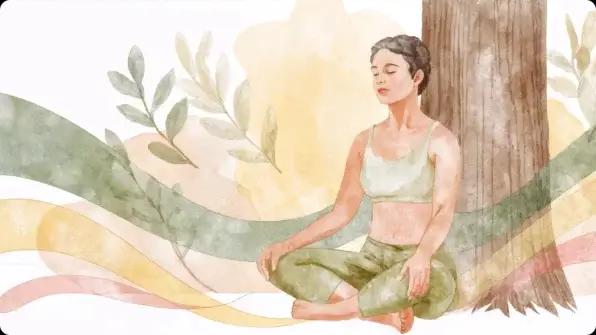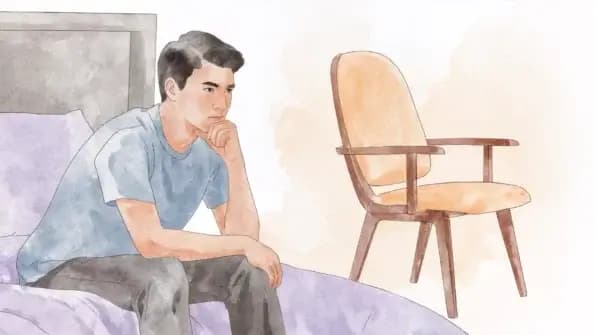When life is full of ups and downs, staying calm can feel like trying to hold onto a balloon in a windstorm. Your mind may wander from past regrets to future anxious thoughts, making every day even more stressful.
Mindfulness is a perfect practice and approach that helps people enhance self-control, affect tolerance, and improve flexibility and mental clarity. [1] If you want to try simple mindfulness exercises and go for more later, save this all-encompassing guide that may help you boost inner peace.
How present and balanced have you been lately? Take a quick test to check in with yourself and explore how connected you are to the here and now.
What is mindfulness?
Scientists define the term ‘mindfulness’ as the ability to observe thoughts, bodily sensations, or feelings in the present moment with an open and accepting orientation toward one’s experiences. [2] Simply put, it indicates a strong dedication to the present moment, without resorting to automatic patterns or succumbing to judgment, distraction, or emotional reactivity.
Practicing mindfulness helps you stay rooted in the here and now, making it easier to be calm under pressure and handle emotions with greater ease. [1]
Among the main benefits of turning to mindfulness activities are:
- Better well-being
- Reduced emotional reactivity
- Improved behavioral and emotional regulation [3]
You can explore mindfulness through simple yet powerful daily practices that ease mental tension. Mindful eating, walking meditation, and body scan meditation are only a few of dozens of approaches that take a few minutes but make a big difference.
The core elements of mindfulness practice
Dr. Shauna L. Shapiro, Linda E. Carlson, and Jon Kabat-Zinn, in the book “The Art and Science of Mindfulness: Integrating Mindfulness into Psychology and the Helping Professions,” highlight 3 core elements of mindfulness activities. Here they are:
- Intention — your conscious desire to improve awareness.
- Attention — noticing what’s happening in the moment, like your thoughts and feelings.
- Attitude — being open, curious, and kind toward whatever you notice.
Besides these core elements, there are also important mindful elements that should be taken into account.
- Acceptance — allowing your thoughts, emotions, and sensations to be as they are without trying to avoid them.
- Non-judgmental observation — noticing your feelings without labeling them as “good” or “bad.”
- Beginner’s mind — staying curious and approaching each experience as if you see it for the very first time.
- Patience — understanding that progress takes time and feeling fine about it.
- Trust — trusting your ability to handle what shows up and believing that you don’t need to “fix” everything right away.
- Presence — fully engaging with the here and now.
Have you ever tried mindfulness activities before?
Quick and simple mindfulness activities for busy adults
You’re ready to start practicing mindfulness. In this section, we’ve collected quick, simple, and highly effective activities that can become life-changing.
1. Body scan meditation
It’s a powerful sensory exercise that allows people to reconnect with their bodies. [4] Everything you need is 5 minutes and a quiet place.
- Sit or lie down comfortably.
- Close your eyes and take a deep breath.
- Concentrate on physical sensations. Start from the toes: notice any sensations — warmth, tension, tingling, or nothing at all.
- Slowly move your attention upward, part by part: feet, legs, hips, stomach, chest, arms, hands, neck, and head.
- If your mind wanders, gently bring your focus back.
- Once you’ve reached the top of your head, take a deep breath and slowly open your eyes.
You can try this practice after a busy day or use it as a part of a daily routine. Moreover, you can also opt for it for better sleep and relaxation.
2. Mindful walking
Among mindfulness activities for adults, this one is as simple as putting one foot in front of the other. Even more, research proves that outdoor mindful walking for one week is associated with improvements in sleep quality, trait mindfulness and mood. [5]
Mindful walking means that you don’t hurry up or live in a constant rush. When you’re going somewhere, you go slowly, relaxed, and with no distractions like listening to music on headphones. There’s no need to dwell on your thoughts — just observe what’s happening around you.
It can help you cultivate mindfulness, calm down, stop feeling constantly nervous, and notice even the smallest details in a busy lifestyle. And, even more, it doesn’t require additional time — you can make any walk you take mindful.
3. Mindful eating
Researchers state that the intention of this mindfulness activity is to help individuals savor the moment and the food and encourage their full presence for the eating experience. [6] Chew slowly, notice the taste of every bite, enjoy your meal, and, again, forget about distractions.
Here are some additional ideas on how to embrace a mindful approach to eating.
- Pause before you eat. Take a moment to look at your food and notice its colors, textures, and smell.
- Notice your hunger and fullness. Stop when you feel satisfied, not stuffed.
- Focus on all five senses — not just taste. Notice the sound of a crunchy bite, the smell, the temperature, and the texture.
4. Loving-kindness meditation
If you’re ready to embrace mindfulness meditation and want to start with something simple yet effective, this is a perfect choice. Loving-kindness is derived from Buddhism and refers to a mental state of unselfish and unconditional kindness to all beings. [7] Here’s how to do it:
- Find a quiet place and sit in a comfortable position.
- Get kind to yourself. You can repeat phrases like “May I be happy. May I be healthy. May I be safe.”
- As you feel comfortable and inspired, expand your circle. Shift focus to someone you love and care about and repeat the same wishes for them.
- Finally, expand your love even more. Feel how you want to be kind to everyone around you — your friends, strangers, difficult people, and eventually all living beings.
- Let the feeling of warmth and care grow with each positive wish.
5. Five senses exercise
If you want to feel grounded in an overwhelming situation or simply practice mindfulness activities with all your senses, this exercise helps you return to the present moment — quickly and with ease. Trauma Research UK suggests that this technique can help break the cycle of anxious or racing thoughts and offer a practical way to regain a sense of control and calm. [8] This is pretty similar to the 333 rule for anxiety, but is a bit expanded.
- Notice 5 things you can see. This can be something you normally notice, like a phone or a bookshelf, or something more unusual. Pay attention to the light reflecting off a surface or the way shadows fall on the floor.
- Notice 4 things you can touch. Reconnect with your immediate surroundings — feel how soft your hair is, how warm the sunlight feels on your skin, or the texture of the chair beneath you.
- Notice 3 things you can hear. There might be birds singing outside, a clock ticking, or even the sound of your own breath.
- Notice 2 things you can smell. Mentally note how fresh the air in your room is, how well your morning coffee smells, or the scent of your soap or shampoo.
- Notice 1 thing you can taste. Chewing gum, water, cookies, or just the natural taste left in your mouth — it can be anything.
6. Gratitude list
Studies prove that gratitude is associated with an enhanced sense of mental well-being. [9] As such, it can be a perfect practice to reduce stress and practice self-compassion.
Your gratitude list can be different — you can use a notebook and write down 3-5 things you’re grateful for every day. You can also craft a big list of what you’re grateful for in general. Or you can make it digital and answer simple self-awareness questions in the Breeze app. This can help you stay on track with your gratitude, build a consistent tracking routine, and gain insights into what makes your life much better.
7. Single-tasking
When people multitask, the cognitive load increases because the brain has to move attention between tasks, which can reduce overall cognitive efficiency, a study says. [6] This mindfulness exercise can help you stay involved, fully concentrate on what you’re doing, and enjoy the present moment. You can also:
- close additional tabs in the browser so as not to get distracted
- put your phone on silent or airplane mode while working
- write or type without switching between apps
Mindfulness activities for adults shouldn’t necessarily be complicated; they can make your daily life better without pressure. You can always adapt them to modern life and stay on track to improve not only emotional health but productivity.
8. Breathing exercises
There are numerous mindfulness activities connected with breathing and the way to approach it. The simplest thing you can try is mindful breathing. According to the study published in 2023, breathing practices may bring stress-reduction benefits thanks to their effects on the autonomic nervous system and brain. [10]
- When you have a few free minutes, close your eyes and concentrate on how you inhale and exhale. Take a few deep breaths.
- Try to do it slowly and prevent your mind from wandering.
- There’s no place for judgment. If you can get accidentally distracted or delve deep into your thoughts, just gently turn your back.
- As you practice this meditation more often, you’ll learn to focus better on what’s happening and remain calm and centered.

Fun and creative mindfulness exercises
If you want it to be fun, engaging, and exciting, turn to creative mindfulness practices or meditation techniques. These are a few of them.
9. Art-based activities
As the main objective of mindfulness is to make you focus on the present moment, art-based activities are perfect for helping you engage fully in the here and now. [11] Among things that encourage mindfulness and help you relax are:
- coloring
- doodling
- crafting
- art-therapy
- painting
- sculpting with clay
- calligraphy
- origami
- photo journaling
Opt for the activity that inspires you most and set up regular time for practice. You can engage in different mindfulness activities for adults — the most important is to shift your focus from your thoughts to your physical sensations and actions.
10. Cooking
This is one more mindfulness practice that allows staying fully present, creative, and involved. Take a few moments a day to pay focused attention not only to mindful eating but to mindful cooking.
Join a cooking class, experiment with tastes, or simply cook something you love most — patiently, attentively, and without the distraction of a new Netflix series. As you chop, stir, and savor, focus on the textures, colors, and aromas, fully immersing yourself in the sensory experience of cooking.
11. Find things that are pleasant to touch
The goal of this exercise is to focus on how everything feels and get grounded.
You can reach out and notice textures around you — perhaps the softness of a blanket, the smoothness of a stone, or the warmth of your cup. Allow yourself to fully experience each sensation. Then, concentrate on deep breathing. Notice how the sensation changes as you continue to focus on it. Try to ground yourself more fully in the present moment.
12. See it, say it
Practicing a formal meditation isn’t necessary if you have no time. Instead, you can observe the surroundings and again turn to grounding. Harold R. Meyer, a founder and Executive Director of The A.D.D. Resource Center, believes that talking out loud sparks positive cognitive and emotional shifts that are beneficial when working through low moods or depressive feelings. [12]
When you’re alone — and, maybe, stressed or overwhelmed — point out the things around you out loud. Yes, it might be weird to say “floor,” “window,” “chair,” etc. Still, you’ll notice how naming the objects around you helps you become more focused on the here and now.
13. Verbal boomerang
Another variation of the previous exercise is to rinse and repeat. It may be especially helpful if you regularly forget what you’ve already done. For instance, you want to engage in mindful gardening. You can say the following: “I am planting the seeds in the soil,” “I am watering the flowers,” “I am trimming the branches carefully,” and “I am feeling the texture of the soil in my hands.” This will help you more deeply engage in simple activities.
14. Write with your non-dominant hand
Using the non-dominant hand regularly increases the ability of the individual to form associations between concepts to solve problems in innovative ways. [13] Try doing things you practice in everyday life — like writing, brushing your teeth, or cooking — with your non-dominant hand. You’ll see how concentrated you become on the task. At the same time, try to notice any distractions, negative thoughts, and judgments that make you feel worse. Analyze them afterward and think about what patterns prevent you from being more mindful.
15. Puzzles
Solving puzzles is also a powerful mindfulness activity for adults. They can sharpen your mind, improve focus, and let you get deeply involved in the present moment. You can solve crosswords, sudoku, matching games, logic riddles, and even try assembling 3D puzzles. The task is to focus on the activity itself instead of just rushing toward the solution or thinking about the outcome.
16. Listen to calming music
Music can have a significant influence in reducing anxiety. [14] For instance, you can turn on nature sounds, soft instrumental tracks, or even your favorite songs. Listen to music without letting your mind wander, and if the song has lyrics, focus on the words and how they connect with the melody. Additionally, you can concentrate on bodily sensations — notice how the rhythm affects your breathing, how your muscles relax, or how your mood shifts with each sound.
Mindfulness for groups and social settings
Studies prove that mindfulness-based group therapy was non-inferior to CBT treatment. [15] So, practicing mindfulness together can be both healing and motivating.
Moreover, fun is associated with positive effects, and that it is enhanced when experienced with others (especially friends). [17] This can particularly strengthen mindfulness practice, as shared experiences help you create lasting positive emotions together.
17. Sound healing
There are dozens of sound healing practices that can be applied to groups to reduce stress and get people back to the present moment. For instance, you can try sound baths, gong balls, music therapy, or even guided humming circles. No matter who you’re trying these mindfulness activities with — whether with friends or a partner to reach a healthier relationship — this shared experience will let you slow down and reconnect with each other.
18. Mindful dance
You can focus on all five senses in completely different ways. Mindful dance is a perfect group practice that can let you concentrate on sounds, the rhythm of the music, the movements of your body, and the space around you. [18]
Seek ecstatic dance groups or groups of any particular style in your city. You can even turn on the music at home and start moving with your loved ones. The essence is to get fully immersed in the process.
19. Mirror movement
Try it with your partner as a kind of mindfulness activity. The essence is simple: two people stand in front of each other and perform the same movements. While one starts the movement, the other needs to repeat it. You can start with something simple and gradually increase the difficulty of the movements. Notice small patterns in your partner’s actions. You can switch roles in a few minutes and do the same thing again.
20. Breathing together
You can engage in mindfulness meditation by practicing breathing with a partner or a group. Take comfortable positions and begin by taking slow breaths together. Try to synchronize, inhale, and exhale together, and feel the natural flow of the shared breath cycle. While this can feel quite intimate, paying attention to each breath can deepen the connection with the people around you. Just stay concentrated, and don’t let your thoughts wander.
We asked Emily Mendez, M.S., Ed.S, to share her ideas on how to practice mindfulness in groups. “Guided meditations are perfect for groups because they are guided. They also provide a sense of belonging and social connectivity. It’s important to create the right environment for group meditations. The space should be free of distractions and comfortable.”
Integrating mindfulness into daily life
It doesn’t matter what mindfulness activities you prefer; if they don’t fit into your routine, you’re likely to give up on them after some time. Thus, it’s better to engage in something simple and not time-consuming. Also, save some tips that will make everyday activities even easier to stick to.
1. Establish a consistent routine
Try the Breeze app for their routines feature. It allows you to set up a goal, choose when you want to get notifications, and track progress. For instance, you can decide that the best time for practicing meditation is morning. So, set up kind reminders and plan your day accordingly (even though it’s only 5 minutes, don’t forget about them in a constant rush).
2. Enhance activities that you already do
For example, you can do a body scan exercise when staying in line or going to bed. Eating or walking mindfully is also a perfect option for everyday practice. If you’re new to mindfulness activities, don’t overcomplicate them; rather, start small and focus on fully experiencing each moment as it comes.
3. Partner with someone
Cooperating with someone can bring additional motivation to be consistent. For example, you can decide to let go of addictive behaviors and replace them with mindfulness activities together with your partner. Try breathing together instead of smoking or going for a mindful walk instead of scrolling through your phone.
Expert Insight
“I think mindful eating is a great way to integrate mindfulness into daily life. Mindful walking is another. Practicing gratitude every day is also a great way to incorporate mindfulness into your daily life. Yoga is another great way to incorporate mindfulness into your day.”
Emily Mendez
Mental health professional
Best resources to support yourself when you practice mindfulness
There’s one more way to simplify your mindfulness journey and take care of your well-being. Turn to additional resources to learn more about yourself, your feelings, and positive psychology.
Apps
Choose apps that motivate you to stay on track rather than distract and pull your attention away from inner feelings. These can be:
- Breeze — routines, mood tracking, fostering gratitude, releasing worries, and relaxation.
- Headspace — meditations for different levels.
- Calm — calming background sounds and sleep stories
- Breathwrk — breathing techniques
Books & podcasts
Discover more about the history of mindfulness, its techniques, and new approaches. Save and try the following:
- The Miracle of Mindfulness: An Introduction to the Practice of Meditation — a book for both newbies and experienced practitioners on how to embrace the present moment
- 10% Happier — a personal and entertaining guide on how mindfulness can make you calmer and more focused, even if you’re a skeptic
- Daily meditation podcast — a podcast with everyday guided meditations to begin your day in the right way
- Mindfulness for beginners — the podcast for those who want to start easily
Guided meditation channels
Pay attention to YouTube and music appreciation techniques, as they help you boost mindfulness and stay fully present. These are the most popular and high-rated ones:
- The Mindful Movement
- Great Meditation
- Declutter The Mind
- The Honest Guys
Conclusion
Mindfulness activities can bring a big change to your life. So, it’s worth practicing them at least once to pay attention to how you feel afterward and notice the difference. Try different approaches and choose the ones that fit your lifestyle. Take advantage of additional resources, like the Breeze app, books about mindfulness, and podcasts, to integrate mindfulness into your days smoothly.
Sources
- Daphne M. Davis, PhD, and Jeffrey A. Hayes, PhD. “What are the benefits of mindfulness?” July/August 2012
- M.P.J. Spijkerman, W.T.M. Pots, E.T. Bohlmeijer. “Effectiveness of online mindfulness-based interventions in improving mental health: A review and meta-analysis of randomised controlled trials.” 2016
- Keng SL, Smoski MJ, Robins CJ. “Effects of mindfulness on psychological health: a review of empirical studies.” Clin Psychol Rev. 2011
- Samuel J.Dreeben, Michelle, H.Mamberg & Paul Salmon. “The MBSR Body Scan in Clinical Practice.” 2013
- Ma J, Williams JM, Morris PG, Chan SWY. “Effectiveness of a mindful nature walking intervention on sleep quality and mood in university students during Covid-19: A randomised control study.” Explore (NY). 2023
- Nelson JB. “Mindful Eating: The Art of Presence While You Eat. Diabetes Spectr.” 2017
- Hofmann SG, Grossman P, Hinton DE. “Loving-kindness and compassion meditation: potential for psychological interventions.” Clin Psychol Rev. 2011
- Trauma Research UK. “The 54321 Grounding Technique.”
- Sansone RA, Sansone LA. “Gratitude and well being: the benefits of appreciation. Psychiatry (Edgmont).” 2010
- Bentley TGK, D’Andrea-Penna G, Rakic M, Arce N, LaFaille M, Berman R, Cooley K, Sprimont P. “Breathing Practices for Stress and Anxiety Reduction: Conceptual Framework of Implementation Guidelines Based on a Systematic Review of the Published Literature. Brain Sci.” 2023
- Child and Adolescent Social Work Journal. “A Scoping Review of Arts-Based Mindfulness Interventions for Children and Youth.” 2020
- The A.D.D. Resource Center. “Here Are a Few Reasons Why I Suggest That Talking Out Loud to Oneself Can Help When Feeling Down or Depressed”
- Louise J. Goddard. “How Using Your Non-Dominant Hand Can Benefit You.” 2024
- Mallik A, Russo FA. “The effects of music & auditory beat stimulation on anxiety: A randomized clinical trial. PLoS One.” 2022
- Hasan MK. “Digital multitasking and hyperactivity: unveiling the hidden costs to brain health.” Ann Med Surg (Lond). 2024
- Sundquist J, Lilja Å, Palmér K, Memon AA, Wang X, Johansson LM, Sundquist K. “Mindfulness group therapy in primary care patients with depression, anxiety and stress and adjustment disorders: randomised controlled trial.” Br J Psychiatry. 2015
- Reis HT, O’Keefe SD, Lane RD. “Fun Is More Fun When Others Are Involved.” J Posit Psychol. 2017
- International Research in Education. “The Potential of Dance as a Tool for Enhancing Mindfulness”
Disclaimer
This article is for general informative and self-discovery purposes only. It should not replace expert guidance from professionals.
Any action you take in response to the information in this article, whether directly or indirectly, is solely your responsibility and is done at your own risk. Breeze content team and its mental health experts disclaim any liability, loss, or risk, personal, professional, or otherwise, which may result from the use and/or application of any content.
Always consult your doctor or other certified health practitioner with any medical questions or concerns
Breeze articles exclusively cite trusted sources, such as academic research institutions and medical associations, including research and studies from PubMed, ResearchGate, or similar databases. Examine our subject-matter editors and editorial process to see how we verify facts and maintain the accuracy, reliability, and trustworthiness of our material.
Was this article helpful?




